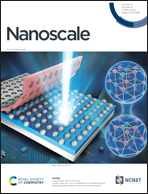Porous honeycomb-like NiSe2/red phosphorus heteroarchitectures for photocatalytic hydrogen production†
Abstract
Heterojunction construction of semiconductors with a matched bandgap can not only help promote visible light absorption but also restrain photoexcited charge carrier recombination and optimize the separation efficiency. Herein, a novel porous honeycomb-like NiSe2/RP heterostructure is reported for the first time by in situ deposition of NiSe2 nanoparticles on the surface of red phosphorus (RP). The optimized binary NiSe2/RP composite showed superior photocatalytic H2 evolution activity (1968.8 μmol g−1 h−1) from Na2S/Na2SO3 solution under solar light illumination, which was 2.32, 1.90, 1.59 and 1.21 times that of pristine RP, NiSe2, 5.3% FeS/RP and 8.1% NiS/RP, respectively. The formation process and function of various reactive oxygen species (˙OH, ˙O2− and H2O2), and the migration pathway of photocarriers are discussed in detail. Such a prominently improved photocatalytic performance could be ascribed to extended light absorption ability, massive reactive centers and lower interfacial transfer resistance, together with expedited charge separation, which arose from a successive two-electron/two-step reduction route. This study provides illuminating insights for the rational exploration and fabrication of potential photocatalytic systems with 0D/3D integrated nanoarchitecture and a multi-step electron transfer process for efficiently realizing solar energy capture and conversion.



 Please wait while we load your content...
Please wait while we load your content...